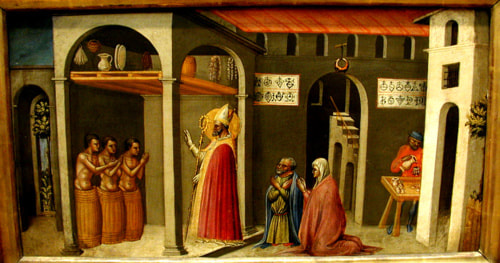|
Gratitude. Intention. Simplicity. Joy. If you were to pick one word for personal focus in the year ahead, what would it be? Clarity. Self-care. Authenticity. Trust. The practice of choosing a word instead of making resolutions has been around a while, but I first heard of it a couple of weeks ago. Resolutions are a set-up for failure, typically forgotten in a month or two. A word isn’t a promise to keep or break, but a lens through which to view one’s life during the year ahead.
Nature’s years don’t start and end, of course; they cycle. Knowing New Year’s Day is arbitrary doesn’t stop many of us from endowing it with a sense of fresh beginnings. Often I’ve chosen something I wanted to leave behind. Last year, Fear turned to ashes in a New Year’s Eve bonfire. Right now the idea of a focus word calls to me more strongly. At this writing it’s Magic, though it has a few more hours to gel. With what rituals do you usher in the new year, if any? What word would you select for focus in 2019, or what from your past is it time to let go?
8 Comments
Childhood Christmas Eves taught me much of what I love. The brightly lit tree in our living room was draped in tinsel, with a home-cut tin star at the top. Having no fireplace, we each hung a sock on the couch, which backed against the wall nearest the furnace pipe. I wondered what difference that made when Santa had to go from chimney to furnace, up the basement stairs, and around through the kitchen. But it worked; the socks were always full the next morning.
We sang favorite carols at the piano and read the ancient Christmas story, illustrated with paintings from the Metropolitan Museum of Art. Our other annual reading was “King John’s Christmas” by A. A. Milne, which still brings me to tears. Lasting lessons from those Christmas Eves: The joy of home and family. Lights, music, art, story. Tradition, ingenuity, wonder. Unconditional goodwill to all, even to bad King John. Image: by Gerard David, 1480s. Metropolitan Museum of Art. This was one of the paintings in the Christmas book I grew up on. A whisper in the ear, a note on the counter, a hand on the shoulder. We use more than one sense to communicate, perhaps all five. Then again, the “five senses” we learned in grade school may oversimplify. What about our ability to sense balance, temperature, motion, or pain? What senses might other creatures have?
Communication goes beyond humans, of course. Animals exchange information within and across species, from the roar of a lion or the warning flick of a whitetail to the dance of bees or the pheromones of ants. More surprising, to me at least, is communication among non-animal organisms, involving senses so alien we turn to metaphors like “language,” “eavesdropping,” or “information highway.” Through underground threads of fungus, plant roots not only poison competitors and share nutrients but also pass information. Aphid-infested broad beans signal aphid-free seedings, through fungal networks, to activate chemical defenses against aphids. Bacteria communicate through chemical signals to act as a group. A grad student at Princeton just published research showing a virus can “listen in” on bacterial “conversations,” using the information to guide its spread from one host bacterium to another. As a specialist in the written word, I find it humbling to learn of communication among life forms of all sorts, probably since before we humans were a twinkle in nature’s eye. This past Thursday, Dec. 6, was the feast of Saint Nicholas, when children in parts of Europe woke to find candy in their shoes. Some had left carrots in the shoes the night before for the good saint’s donkey. Carrying a saint with his bag full of sweets is hungry work.
Patron saint of children, seamen, and travelers, Nicholas (280-343) was a bishop known for his gifts to those in need. He’s said to have saved three sisters from being sold into slavery by providing gold for their dowries. In another old tale, illustrated above and retold in Benjamin Britten's 1948 Saint Nicholas Cantata, an innkeeper killed and pickled three boys for meat during a famine. The good saint stopped unwitting customers from eating them and brought the boys back to life. If you want to throw something different into the sweet seasonal mix of lore, carols, and movies, you can always conjure up Saint Nicholas and the pickled boys. Image: Saint Nicholas Resuscitating Three Youths, by Bicci di Lorenzo, Florence, 1433-35. Metropolitan Museum of Art. Public Domain. “It is sweet, when winds trouble the waters on the great sea, to behold from land the distress of others, not because it is a pleasure that any should be afflicted . . .”
- Lucretius, On the Nature of Things, Book II Few of us deliberately seek out life situations to make us sad, anxious, or furious. Yet paintings, music, and poems that arouse those feelings keep us coming back for more. On a peaceful, contented evening at home, you’ll find me reading a murder mystery novel. Philosophers call this mismatch the paradox of tragedy. If the arts have one overarching purpose, it’s to make us feel. To feel is to be deliciously alive. Within limits, what we dislike about a “negative emotion” is not the sensation so much as the situation behind it. When art lets us relish intense feeling without suffering the actual loss, hazard, or injustice, it offers the best of both worlds. |
AuthorI'm a historian who writes novels and literary nonfiction. My home base is Madison, Wisconsin. Archives
July 2024
|


 RSS Feed
RSS Feed